Girls Discover that Engineering Is Sweet at Introduce-A-Girl-to-Engineering Day

An high school participant makes an airplane during the Aeronautical Engineering session of Introduce-A-Girl-to-Engineering Day.
March 7, 2017
About one hundred girls (and their parents) from around the state (and even a couple from out of state), showed up at the 2017 edition of SWE’s Introduce-a-Girl-to-Engineering Day (IGED). The largest SWE (Society of Women Engineers) outreach of the year, it was held at Illinois on Saturday, February 18th. Not only did the participants learn a bit about the different engineering disciplines, they learned that like many of the female role models at the event, they too could do engineering and make a difference in other peoples’ lives.
The theme of this year’s IGED was "Engineering is Sweet." So what could be more apropos than having candy littered throughout the different venues. “I mean, who doesn't love candy, or everybody has a little bit of a sweet tooth,” acknowledges Molly McGiles, one of SWE’s Outreach Co-Directors. “So we're trying to just relate everything to what girls understand.”
Along with Hershey’s Kisses, the day’s events were also designed to show the girls just how sweet Engineering can be! So the keynote speaker, Engineering Ph.D. student Aadeel Akhtar shared with the girls how he’s making a difference in people’s lives by designing low-cost prostheses as part of his research, and his new start-up company, PSYONIC.
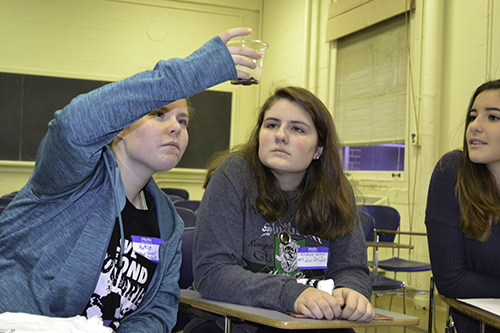
High school students do an experiment electroplating a quarter with copper from pennies
Then, the high-schoolers rotated through several hands-on activities related to different engineering disciplines. They extracted DNA from strawberries; soldered lady bug bots; electroplated quarters with copper from pennies; experimented with drinking water purity; experienced rapid prototyping; designed, built, and flew wooden gliders, and even learned about industrial engineering through a paper-airplane-building assembly line competition which stressed not only speed, but quality.
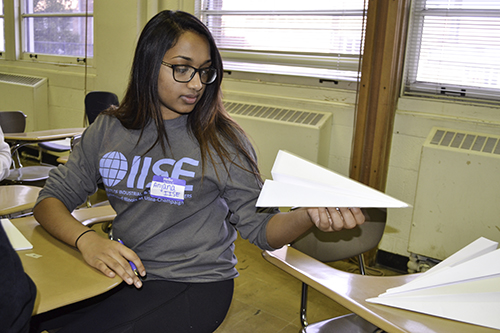
An Illinois Industrial and Systems Engineering student participates in an assembly line while helping her team of high-schoolers learn about lean-quality engineering.

Members of the Materials Advantage RSO explain a bit about materials science during their hands-on activity.
McGiles shares an anecdote about the Lean-quality engineering activity. Girls were to make paper airplanes from a stack of paper, assembly-line fashion. Then they had one final colored piece of paper and were to see how long it would take them to get it through, and if it was the same quality at the end. Before the activity, some girls were skeptical, exclaiming, “‘Oh my god, we're going to make paper airplanes!’ and then towards the end they were like, ‘No, I think we can make this better if we do it this way!’ I was like, this is what we need! This is why we do this, to see these girls become engineers and fix these problems!”
Leading these activities were around 30+ volunteers from nine different RSOs (registered student organizations), who were on hand to share their love of engineering with the girls. IGED co-chair Katherine Kiang explains:

An IGED participant extracting DNA from strawberries.
“So we like to invite a large number of RSOs to come so that the students can see a wide variety of student groups, and it also allows us to have smaller rotation numbers so they get more personal interaction.”
Following are the participating RSOs:
- AIChE (Chemical Engineering)
- ASME (Mechanical Engineering)
- BMES (Bioengineering)
- Illini Aerospace (Aerospace Engineering)
- ISESE (Industrial Engineering)
- Material Advantage (Materials Engineering)
- SEM (Mechanical Engineering)
- WECE (Electrical and Computer Engineering)
- WEF-AWWA (Environmental Engineering
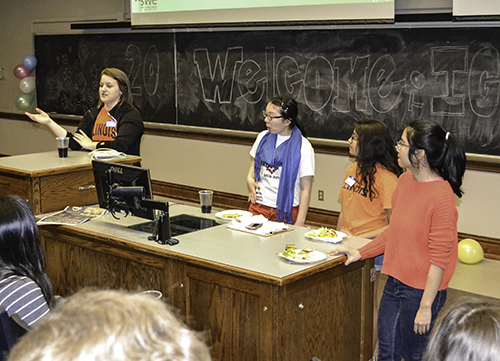
A panel of Illinois Engineering students answers students' questions during lunch.
Following the hands-on engineering activities, over a pizza lunch, a panel of current Engineering students shared what it's like to be a student at Illinois, some tips for success as a student, plus answered participants' questions.
IGED organizers also hoped to help the high-schoolers understand a bit about research. So instead of the lab tours offered in the past, they came up with a Poster Walk featuring research done at Illinois by undergrads, grad students, and postdocs.
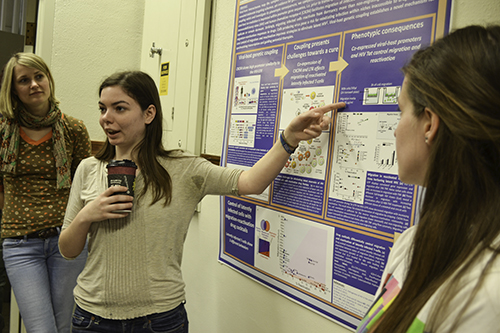
A Ph.D. student (left) watches as one of her two undergraduate research assistants presents their resesarch during IGED's Poster Walk.
The event planners felt it would “be really helpful for them not only to meet graduate students who are doing really cool work, but also to be able to see it and actually learn about the research,” Kiang explains. Typically in lab tours, “They just see the lab,” she continues, “and when the professor's speaking, it can go over their head.” So IGED organizers felt hearing from students would be more effective.
According to McGiles, the Poster Walk was also intended to prepare the girls for one of the key events of the day—the design challenge. So during the Poster Walk, girls would get “A first-hand experience of what a designed poster should look like when they go to create theirs at the end of the day…because they do a design challenge, so they get to see what real people here at Illinois are working on and how those projects look on paper, so they can reproduce something of similar value.”
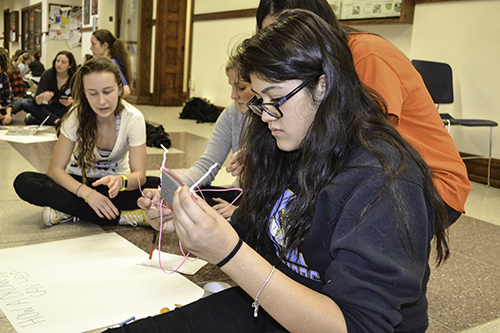
A student works on her team's prototype (foreground), while she and her team come up with a poster for the design challenge.
During the afternoon design challenge, the girls were to come up with an engineering solution to address a present-day problem, design a prototype, and create a poster to present their idea to visitors (including parents) during the end-of the day poster presentation.
However, parents didn’t just kill time waiting for the final poster presentation. After attending the opening session with the girls, they had their own set of activities: talks from an admissions representative and Angie Wolters, Assistant Director of WIE (Women in Engineering), a tour of Engineering campus, and even a Trivia game. In charge of the parent activities this year, McGiles reports that some of the categories included what their daughters had been learning in the morning, fun facts about Illinois, fun facts about sweets, and one that was a bit more informative, like "How can you advocate for your daughter?"
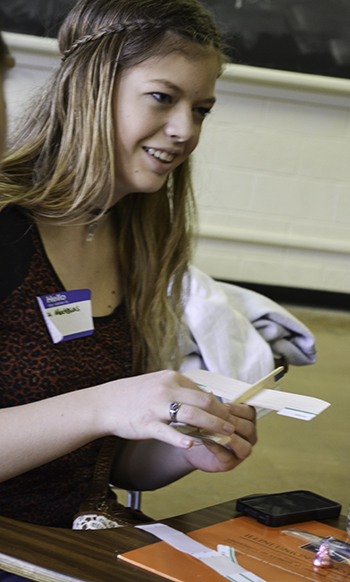
IGED participant prepares to test the airplane she just finished designing.
In a nutshell, the goal of Introduce-a-Girl-to-Engineering Day, was to pique girls’ interest in engineering as a career. According to Katherine Kiang, it’s “about exposing girls to engineering, and showing them that they can be an engineer, and giving them that confidence.” She adds that exposing the girls to women who currently do engineering is a big part of the goal: “just showing them that there are very strong female engineer role models who make a difference and that they can be one of those, too, and just trying to inspire them to consider engineering.”
Relishing the opportunity to serve as a role model for the girls, SWE Outreach Co-Director Abbie Gerth, reports that her friends got her involved in IGED a couple of years ago, and she’s been involved with SWE outreach ever since.
“My good friends and roommates, they really love doing this outreach, and I saw how much joy they got from seeing these kids learn, and I was like, ‘Hey, I kind of want that. That looks exciting!’ So I thought I'd try it. I've always loved helping people, so it kind of just goes hand in hand, sharing my love of engineering and helping, reaching out to these girls.”
Similarly, McGiles indicates that she participates in IGED to recruit more girls into engineering. “As a woman in engineering, I'm passionate to see more women in engineering, and this is the next generation of girls who would be going into that.”
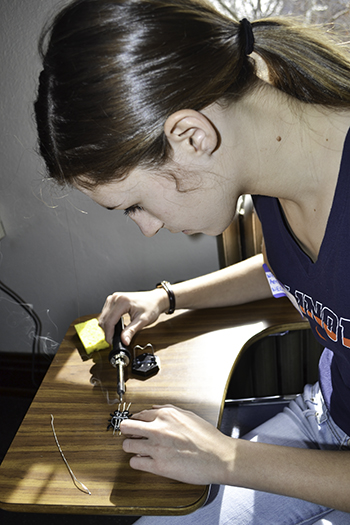
A student learning how to solder for her project.

A student soldering her lady-bug bot.
McGiles says the high-schoolers find discovering that one of the Engineering students grew up near them to be particularly significant. “I also find it so fun when girls come to this event,” she admits, “and they're like, "Oh I'm from Winchester!" or "I'm from Jacksonville!" and they're close by, and you just have that connection with somebody… "Oh, this girl lives next to me, and now she's doing all these big things! I can do it!"
What kind of impact did the outreach have on the visiting high-schoolers? Gerth, a senior in Mechanical Engineering, who looked in on different activities from time to time, reports, “I was actually just with the soldering, with the electrical engineering group, and I could see those girls really getting into it. They really loved having that hands-on, real-world engineering experience, and I could see their eyes light up. They really wanted to do it.”
McGiles, who also dropped in to watch the girls doing the activities, shares a couple of anecdotes. She reports that one girl doing the soldering hearts activity was asking, “‘What temperature is this actually at? And could you do it at a lower temperature?’ I was like, when I was in high school, I would just do the activity; I'd be like, ‘Oh this is fun!’”
Several participants share why they came to IGED and what kind of impact it had had on them. For instance, Hannah Cannon, a high school junior came, “Just to learn more about engineering and the different fields that are here. To maybe know what I want to do when I get older.” Of the disciplines she’d been exposed to, she appeared to be leaning toward mechanical engineering.
“I liked mechanical a lot. It was fun to do all that—design and build things.” She particularly enjoyed the collaboration aspect of the design project: “It was fun to talk about everyone’s different ideas for one problem to find an eventual solution that everyone can agree on. Nice to see how different everyone is and their different points of view. It ended up being a really good thing to do, and I learned from it.”
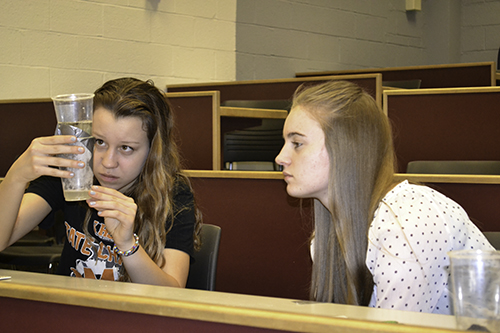
In the Environmental Engineering activity, two high-schoolers examine their water purity experiement.
Anisha Narayan, a junior at Cohen High School in Winchester, Illinois, participated in IGED because she has been on a college tour here and had started following the Women in Engineering website. So when she learned about IGED, she signed up!
Anisha wants to go into computer science. While she’s known it’s been computer science all along, she acknowledges, “but it was kind of nice to get exposure to the electrical engineering side, ‘cause I’ve had some exposure to circuits, and I didn’t really like it, but I really liked what I did here today.” The activity was a little lady bug bot they were programming for the lights to turn on when they soldered on the battery. “Mine didn’t work,” she confesses, “but other people’s did work.”
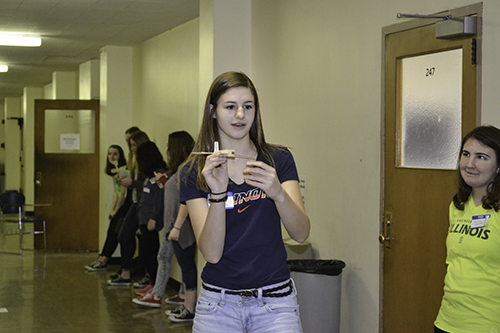
Above: IGED participant Kelsey Belle prepares to test the airplane she just finished designing.
Below: Belle's glider soars successfully.
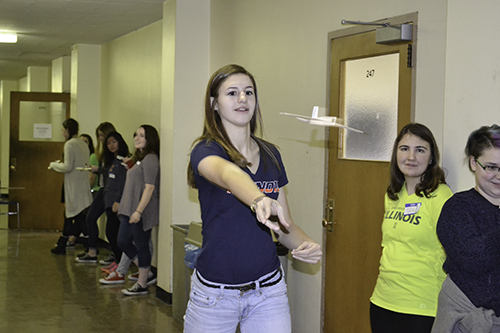
Another participant, Kelsey Belle, a senior at Naperville North High School, admits that, “Weirdly enough, I more of an art person. I enjoy computers in engineering, and I like the creative aspects of it. It’s kind of a weird way to look at it, but that’s how I view it. It’s an art form.” Her goals are to do computing and digital media. “It’s a little bit of both!” she admits.
Sydney Nichols is a junior at Blue Ridge High School. “It’s about 20 minutes from here. I’m local,” she says. Regarding math and science, Sydney proclaims, “I love it. I love it!” Sydney, who thinks she wants to be an engineer, proclaims, “I really liked electrical. When we did the circuits, that was really fun.”
The parents appeared to enjoy it too. One set of parents, Matthew and Linda Surlovski, who brought their two daughters: Hannah (a junior) and Lindsey (a freshman), report, “I think it's really great—very excited. Everybody seems to be presenting the department. Everything's been wonderful,” adding that the event had been, “Answering all the questions we've had.”
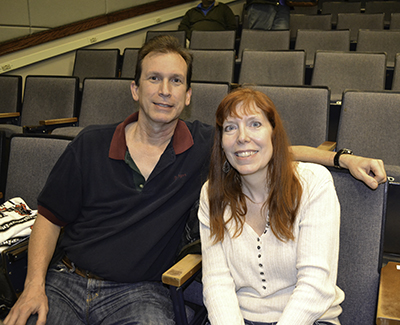
Matthew and Linda Surlovski, brought their two daughters: Hannah (a junior) and Lindsey (a freshman) to IGED.
Matthew, an Illinois alumnus himself, wanted them to attend IGED because, “They both enjoy math and science, so I thought they might enjoy seeing the campus and taking a look at the engineering program.” Plus, because Hannah had gone to and enjoyed an engineering camp at another university last year, Dad admits, “We wanted her to see the campus here, and take a look at and see what the opportunities are for women.”
McGiles indicates that many current Engineering students, like IGED co-chair, Maddie Pool, ended up at Illinois as a result of participating in IGED as high-schoolers—which makes the event particularly rewarding. “So to just see people come back,” admits McGiles, “and to just see them being successful is really awesome.”
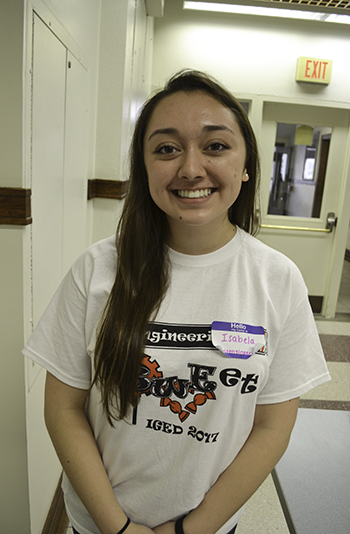
Freshman Bioengineering major, Isabela Pelikan.
Take IGED chair liaison, Isabela Pelikan. A freshman in Bioengineering, she got involved because she knows first-hand what kind of an influence IGED can have. A participant herself as a high school sophomore, she calls its impact “A huge one, because it made me decide to come here, actually. It was a great experience.”
What in particular about IGED influenced Pelikan the most? “The promotion of women, specifically in engineering, because I did not know a lot about engineering. My mom actually pushed me to go to this, and I was like, ‘Okay, you know, why not?’ because I didn't know much about it. I don't know, I loved the whole inclusion of women because we're so underrepresented, so that was really cool. And then the design challenge was a huge thing, because we actually won it, so that was really fun. But, yeah, it was awesome!”
Dad was supportive too. “My dad's like, ‘Oh, I can see you doing this one day!’ she acknowledges, “and now…” Here she is, studying Bioengineering at Illinois!
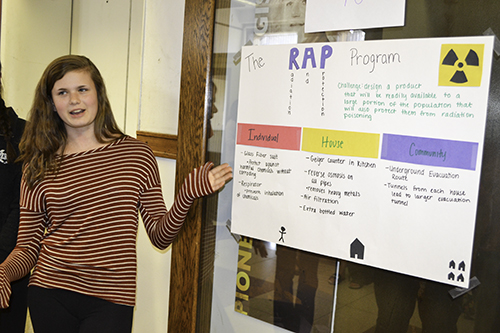
An IGED participant presents her team's design project.
Kiang expressed the IGED committee’s appreciation: “We just want to thank everyone who's helped out with this event, from our speakers to our judges, our student organizations, and our volunteers from the Society of Women Engineers, this day wouldn't be possible without them and it's always really cool to see it all coming together.”
Story and photographs by Elizabeth Innes, Communications Specialist, I-STEM Education Initiative.
More: 8-12 Outreach, Engineering, Open House, SWE, Underserved, Women in STEM, 2017
For additional I-STEM web articles about Illinois' partnership with Booker T. Washington STEM Academy, see:
- Introduce-a-Girl-to-Engineering Day Tells Girls: "You Can Be an Engineer, Change the World!”
- SWE's "Save the World With Engineering" Outreach Targets Middle School Girls
- Introduce-a-Girl-to-Engineering Day Tells Girls: "You Can Be an Engineer, Change the World!”
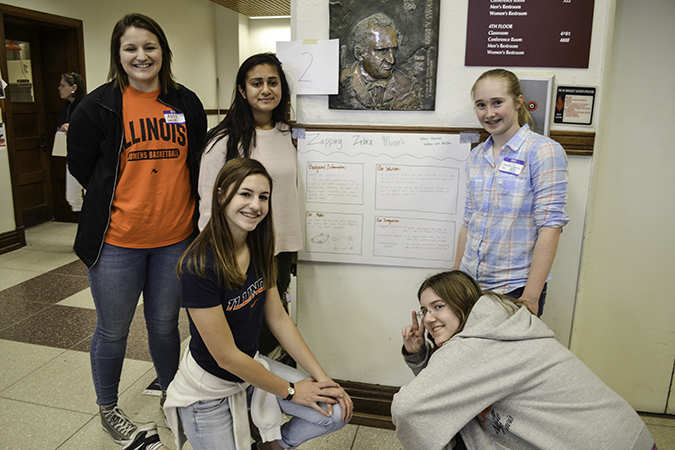
Clockwise: Illinois Engineering student Abby Pakeltis, Anisha Narayan, Hannah Cannon, Sydney Nichols, and Kelsey Belle by the poster they created. Their project, Zapping Zebra Mussels, dealt with how to prevent zebra mussels from swimming into pipes and clogging up plumbing along the California coast..













.jpg)
















